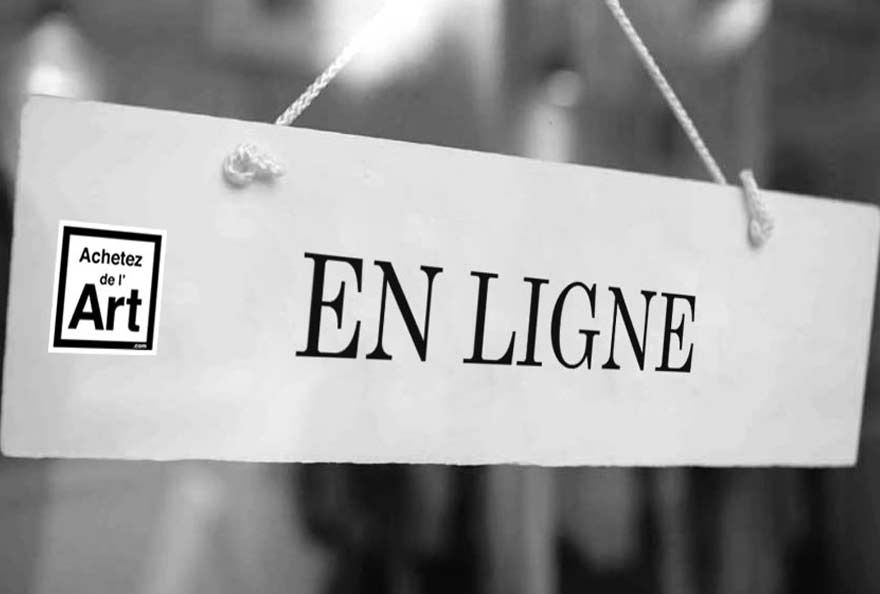While the art market has long been spared by digital technology because it was considered incompatible, it has been undergoing its digital transformation for several years now, thanks in particular to the development of online art sales, which are growing very strongly. In fact, it grew by 24% last year, and on the basis of this trend, online art sales could reach 9.58 billion $ by 2020.
From digitalization to the democratization of online art
Ahe digitalization of online art is also a question of generation. It is true that older people, due to their greater purchasing power, are still the biggest buyers of works of art today, and not only through "traditional" channels, since 51% of art buyers also do so online.
But the native digitals, who are almost 30 years old, are likely to start, today, to take an interest in buying art. It is a generation that is going more and more to the web to search for information or to make purchases. It was therefore only natural that the many online platforms and art galleries should also seek to meet their needs.
The purpose of these platforms is to democratize art by making it accessible to all. The idea is to enable them to buy art easily, and to offer works for all budgets. A few years ago, it was still difficult to start buying art: people didn't dare to push the door of a gallery, the buying process was so closed that few people dared to take the plunge. But today, art is no longer reserved for the elite.
Thanks to digital, anyone can start a small collection, whether for emotional pleasure, social reasons or investment, the act is easy. We are therefore witnessing the "birth" of new, younger, less elitist buyers. In 2016, it is estimated that 46% of 18-35 year olds have already bought art online. Our "Art Trade Report" study also reveals that 68% of 18-35 year olds will buy more, through online sales sites (53%). Emotional pleasure is the main factor driving them to the act of buying for 92% of them.
But why such a craze for online art?
The strength of online art is first of all to offer an extremely wide variety of choices, much more than in a physical gallery. Thousands of works, from all over the world, are available to everyone. Thousands of international artists are now within a click's reach, which multiplies the chances of finding a favourite.
Collectors no longer have to scour galleries to find out about an artist they love. They can simply consult sites to get as much information as possible before calling in an expert, if necessary. The Internet also offers more transparency to buyers, especially with regard to prices. The prices of works are clearly indicated and auctions are more efficient and targeted. In addition, online art galleries offer discretion, which can be an important criterion for buyers when buying rare or sensitive works.
Finally, we are witnessing a uberization of the online art market, where auctions and fixed-price sales, sales models with and without intermediaries coexist. New intermediaries are entering the sector and established models are changing. In the United Kingdom, for example, antique dealers have decided to set up their own auction sites so that they no longer have to go through auctioneers. Buyers now go directly through dedicated websites and no longer have to pay extra fees, as they do at auctions.
Contemporary art, a big favourite on online art platforms
In our "Art Trade Report" study, we surveyed 127 galleries and art dealers representing a wide range of art and collectibles. 63% of these galleries were contemporary art galleries. If this art is highly successful online, it is notably because the platforms feature many emerging artists, who are not yet popular and whose works are still affordable.
Depending on the platform, it is estimated that the works that sell the most are between €500 and €2000. Beyond these amounts, buyers face a psychological barrier, they spend less because they still need to see the work in reality.
What about traditional galleries?
In this rapidly evolving artistic context, the role of traditional galleries is also changing in order to adapt to these new distribution methods.
28% of those surveyed in our study indicated that they now offer their customers the ability to buy and pay online, an increase from 2013. However, it now seems that they are lagging behind because they are still hesitant. They have not yet been able to implement a real strategy.
In France, more and more companies are launching their websites in order to promote themselves beyond physical borders and reach new customers.
Nevertheless, friction remains between the traditional model based on the relationship with the gallery/art dealer and the online "click and buy" model, where the interaction between buyer and seller is often limited, if not simply non-existent. Nevertheless, traditional galleries have something that digital technology will not be able to replace: that special atmosphere, that exciting ritual of discovering a gallery and its works.
To adapt to the market, some galleries use intermediaries who can support them in their digital presence. 41% of the galleries reported that they were making online sales through third party sales sites and 26% of them plan to partner with a third party e-commerce platform in the near future, but online galleries as well as traditional galleries should not neglect their presence on social networks, as this is one of the best ways to stay close to their customers and potential buyers.
In short, while digital channels are essential for traditional galleries to reach and strengthen the relationship with their current audience and clientele, they are also a great opportunity to access new markets!


 Nicolas KaddècheHead of Art Market and Private Clients at
Nicolas KaddècheHead of Art Market and Private Clients at 









